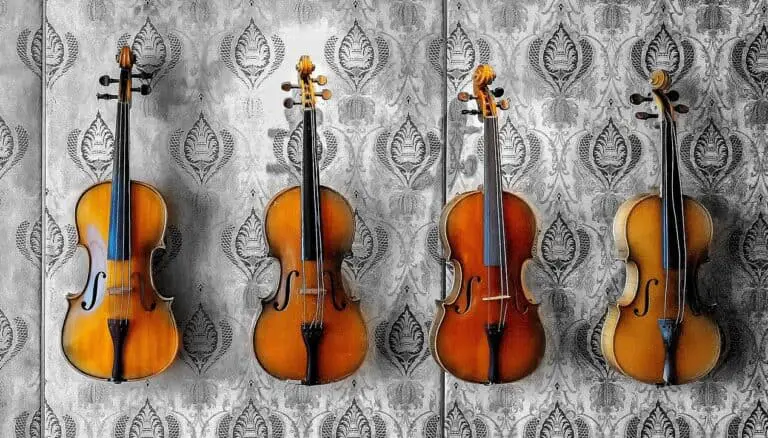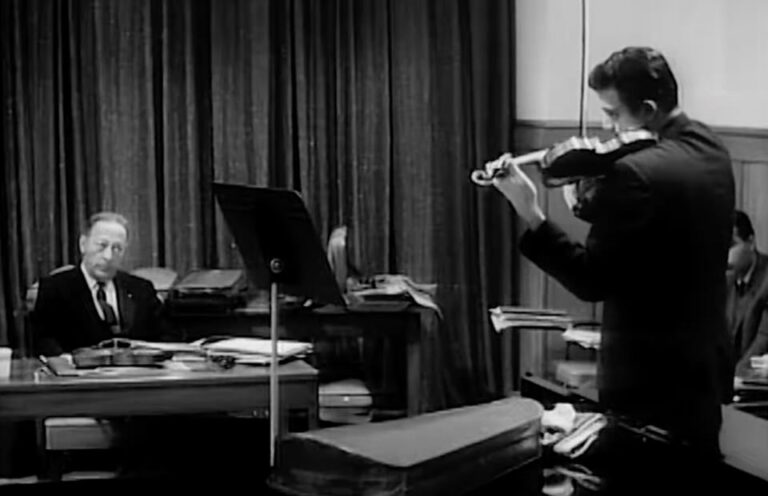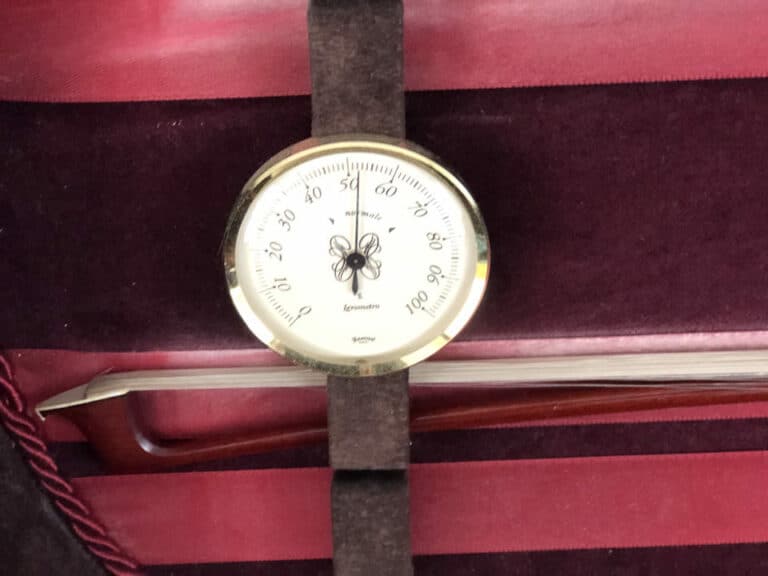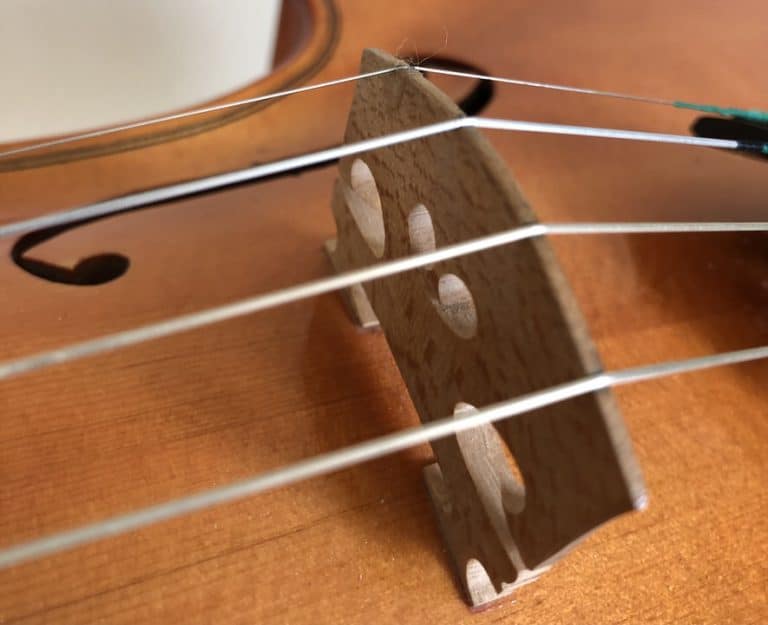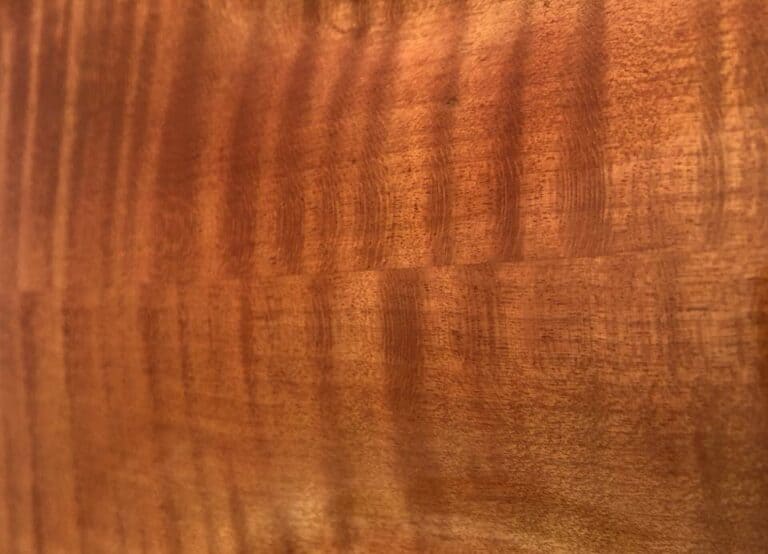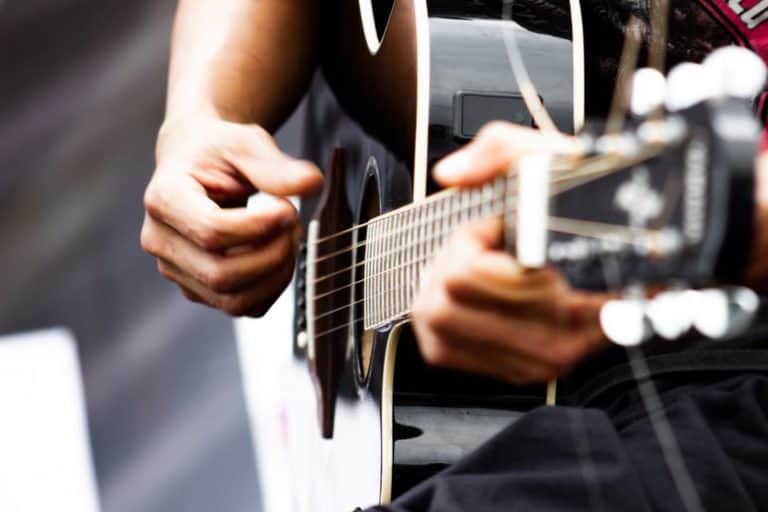Take Maximum Care of your Violin Bow: How and Why you Should
Violin bows are often overlooked. They appear to be an accessory to the violin, the real thing. A bit like a pick to a guitar. But bows play a crucial part in how violinists play their instruments. On the same violin, from one bow to another, the sound differs a lot. The bow vibrates in sympathy with the string it strikes, and with the violin.
Every serious violinist should have his or her bow(s) in absolutely perfect condition for the sake of sound and playability. The hair should be new and the rosin has to be applied perfectly. The bow stick has to be clean from rosin. The screw has to work perfectly to accommodate quick adjustments on the spot. And more importantly, the stick has to be straight.
These might appear to be a detail. But they are not. Each and every small detail eventually add up and make a big difference. Why spend so much time practicing a bow stroke if your bow doesn’t bounce properly? How to get a good sound if your bow is worn out? And lastly, how to play chords confidently if your bow has no stability at the frog?
What you can’t do yourself: ask for the help of your bow-maker.
A violin bow is a very technical object. Some maintenance can only be made by a specialist. The first important thing about a bow is its hair. It is the part that is in contact with the string and actually produces sound. So it has to be in perfect condition.
Have your bow-maker re-hair your bow
How often do you have to have your bow re-haired? For professional musicians who play a lot (on that bow, that is to say), three or four times a year is usually the average number of times. For a serious student, I would say once a year. Irregular amateurs sometimes keep the same hair to their bow for several years (and they shouldn’t).
We have detailed extensively how the sound is produced on the violin with the Helmholtz-Motion on this blog post. For the hair to be able to pull the string, it needs:
- its microscopic scales cause friction with the string. Indeed, the small hair is not just nylon, for example, it is made from horsetail hair. As a hair, it has scales that pull the string at a microscopic level. A nylon wire wouldn’t make any sound because it would just slip on the string,
- a surface structure to hold a small and even layer of rosin that will apply friction on the string.
If the bow hair is worn out, those scales are worn out as well and do not exert friction on the string as much and your sound will be tiny, airy, more prone to be surface sound.
Your bow-maker will install a new bow air. It generally takes around 60 minutes of work. My archetier usually lets me sit there and watch, admiring the fine art of servicing a bow.
Re-hairing a bow usually costs between $40 and $60, ask your favorite maker.
A new bow hair will be evenly distributed as opposed to worn out differently on one part of the bow compared to the other.
If bow hair is worn out, it is more prone to break, and, if so, on the part of the hair you play more with. (We usually never play with bow hair completely flat on the string). If hairs break mainly on one side, there is an imbalance that results and can give the bow an unstable temperament.
So a good new bow air is not only important for sound but also stability and elasticity (rebound).
Now that your bow has new hair, the sound will be more defined, focused, clear. And the bow will be more stable and predictable. But your maker will do more care to your bow, while at it.
Have your bow-maker check the camber of the bow and correct it
A bow is alive, vibrant. It is called a bow for a reason: it has to be elastic, bouncy. But that elasticity has to be controlled by the right arm.
To have a perfectly stable bow when you want to, and a bow able to execute saltellato, spiccato, flying staccato, or even jeté when you need to, the stick has to be in perfect form.
- The camber of the bow has to be good (PICTURE). If you have tightened your bow too much for the last couple of years, the camber can fade out and the bow becomes flatter. That is not what you want. Only the bow-maker can correct that by carefully heating up the stick and slowly apply force to the stick to recreate the camber back. Your bow will get back in top form and you won’t recognize your saltellato after that. You understand now why loosening your bow correctly is of great importance.
- The bow has to be straight or it won’t be stable. If the hair of the bow has been kept too much after being worn out, chances are there is an imbalance between each size of the bow hair depending on the hairs left. After months, the bow is not straight anymore. Your bow-maker will correct that and give you back a straight bow. Even better: if you play (like many violinists) with your bow slightly leaned towards the fingerboard, then again there is a lateral force applied to the bow. Your bow-maker, as a great professional, will anticipate that and slightly curve the bow the other direction to compensate for that.
Now that the bow is straight and its camber corrected if needed, a new bow hair will help keep it in good condition.
Oil or varnish the stick of the bow
One last thing that the bow-maker will usually do is clean the stick. It is easier to do without its hair. They have always a secret sauce to clean the bow perfectly. Then, they apply a slight amount of oil varnish to “feed” and saturate the wood, and to protect it from your epic playing sessions.
What you can do yourself to take care of your bow
Now that your bow is out of your favorite bow-maker, there are many things that you can do, must do would say, my Maestro, to keep it in perfect condition.
How to clean your violin bow
The first thing is to clean your bow regularly.
- Remove excess rosin from the stick. This is something I do after each session. I use a clothe to wipe out the rosin from the part of the stick that gets in contact with the hair. With a different clothe, I clean the top part of the stick which is usually cleaner already. By doing so regularly, you won’t let rosin build-up, and be sticky and difficult to remove. Each couple of months, I do a special clean of the stick. I vaporize alcohol slightly on a makeup-removing disk and use that to clean the stick lightly. You shouldn’t see or feel any alcohol directly on the stick. But the tiny small amount vaporized on the cotton will help remove the rosin. Your stick will be shiny and new after that.
- Remove dirt from the pad, winding, and grip (there is nothing worse than a bow with hand dirt on those parts). I usually use make-up removing disks again with vaporized alcohol to clean that. I put a bit more alcohol than for the stick though. If done regularly, these parts will be impeccable.
- Clean the frog of the bow. For that, I use a cotton swab with alcohol. It is quickly done and particularly rewarding to admire shiny button, pearl, and inlays.
My bow-maker told me he was amazed at how much dirt he has to deal with on bow from good orchestra professionals. This won’t happen to your now.
Take care of your bow frog
You tighten and loosen your bow many times every time you practice or perform. You have to be able to do it quickly and easily. If your frog is hard to operate, you can perfectly service it without going to your bow-maker.
You can do it, though it seems to be scary at first. Unscrew your button completely and pull it from its location. Then the frog comes off completely. This is normal behavior.
Now that the frog is loose, clean perfectly the stick where the frog slides. Again, use vaporized alcohol on a makeup-removing disk. It would be better if you had a bit of bow-maker special sauce for that matter, but you can do without that.
Clean the same way the part of the frog that slides on the stick.
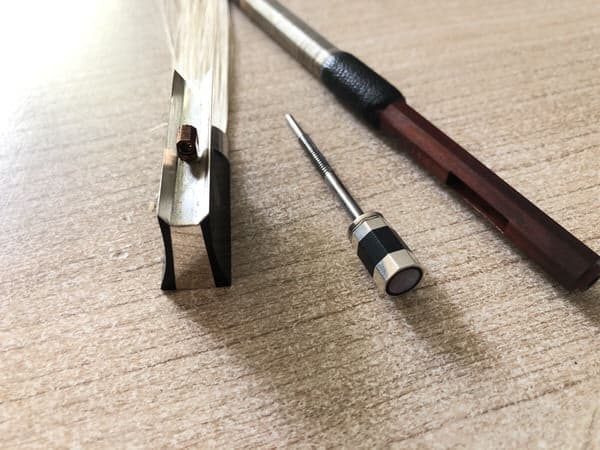
Now, clean the screw itself. Remove all traces of rust from it. It has to be perfectly clean. You can put a really small amount of grease on the screw before putting it back together.
Let everything dry out and put your bow back together. You will instantly feel a great difference in operation when you screw your bow to tighten or loosen it.
Always keep your bow within a good tension range
To keep your stick in good condition, never tighten your bow too much ( you should always see the camber of the stick) and the hair should be at the limit of touching the stick when you play hard, but not much more. Of course, it gives a bad sound when the stick accidentally hits the string on top of the hair. But do not tighten your bow too much to avoid that.
Always loosen the bow and unscrew it after each playing session to ease the tension. Unscrew always more than you thought you had to because, with differences of temperature and hygrometry, you can find back your bow tighter than you’ve left it. It has occurred to me many times. To be certain, always loosen your bow more than you think is necessary.
This will protect your bow hair but also your stick which remains straight and with a good camber.
How to put rosin on your bow the correct way
The first time you put rosin on your bow after a re-hair can be tedious and long. This is normal. The new hair slips on the rosin and doesn’t grab much if any. Bow-makers have rosin in powder to speed up this process. You can buy rosin powder yourself and rosin your bow quicker. But there are two drawbacks: you won’t need rosin powder often enough to justify the (small) investment unless your play several bows and have them re-haired several times a year. Plus, you might not be able to find your rosin of choice in this form factor. So it isn’t a good idea to start with a rosin powder type different than the rosin you prefer sound-wise.
Alternatively, you can take some powder on one of your other bows with your newly re-haired bow. You will speed up the process and then go on with your rosin.
Then apply rosin lightly, from the frog to the tip of the bow, regularly, in large motion. Don’t apply strong pressure in small motions back and forth. You might wear out the hair quicker. Think of gathering rosin dust rather than forcing it in. Rather, angle the bow back and forth to apply rosin on every part of the bow hair, not just the down part.
Finish off by making sure the tip and especially the frog have a good amount of rosin as well. Then make sure you do not put too much rosin on your hair bow, otherwise, there will be a cloud of dust that will spread out on the violin. It will serve no purpose on sound or playability but will be hard to clean. If you see a cloud of rosin, immediately remove some by swiping the hair with a cloth.
It is better to apply rosin in small quantities regularly rather than putting too much at the beginning of the day anticipating a long session.
For further details, I have devoted a whole article on that simple but tricky subject, read bow rosining best practices.
What to do with loose or broken bow hairs?
Those things happen, this is perfectly normal.
This is part of the natural wear and tear of a bow. The more you play, the more you encounter the risk of breaking hairs. Differences in temperature and hygrometry play a part in breaking hairs as well.
If a hair is broken, just cut it with a knife or scissors close to the tip and frog. It is not recommended to pull strongly to break the hairs not to damage the way they are fastened by the bow-maker.
If your bow misses some individual hairs, you will be able to play with no problems whatsoever.
But if there are too many bow hairs that break, especially on the same side of the hair, this can have bad consequences because an imbalance will appear. The bow stick might not be straight anymore, this is the risk. So as soon as more than, let’s say 10 individual bow hairs break, I recommend it is important to have your bow re-haired. Anyhow, it is a sign of things getting worse.
So some hairs break? Just cut them off. If more than ten are loose or broken? Time for a re-hair.
How to Store your violin bow correctly
Your bow needs a good case as well. It is perfectly fine to store it within your (good)violin case. But if you want to carry it independently, you should invest in a special bow case. Never put your bow in something else than a bow case or a violin case. Bows might appear to be strong and flexible, they are fragile nonetheless and easily broken.
If you intend to leave your bow stored for a long time, loosen it even more than usual, because you will find many broken bow hairs anyway when you come back.
How long does your violin bow is expected to last?
Now that your bow is in perfect condition and that you know how to take care of it, it will last forever. Good French bows from Pecatte or Tourte (eighteenth century) are still in use today.
The number one factor that damages bows is too much tension. Some virtuoso who play in large halls tighten their bows a lot and wear them out quickly. The bow-maker can re-camber them so many times, and after some point, they aren’t good for service anymore.
The number two factor consists of accidents. Dropping a bow on the floor or worse playing hard against an object we haven’t seen.
When I was a small kid, I broke a bow by playing too close to a wall. This won’t happen to me again. But if a stick is broken, there is no way a bow-maker will glue it back into service.
So take care of your bow and it won’t hinder your technique in any way and will share your music life for a long time!
Now that you know how to take care of your violin bow, read further: I have explained how to store your bow the right way to give it extra protection. And I have a complete blog post on how to maintain and take care of your violin with the help of your luthier or by yourself.

